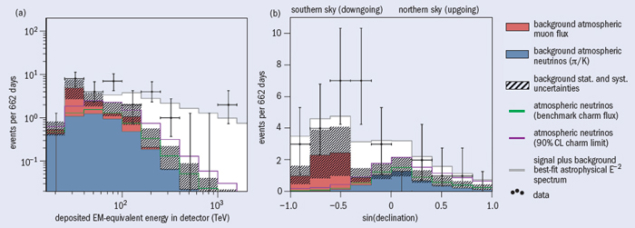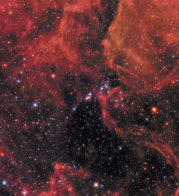
The IceCube collaboration has reported evidence, at the 4σ level, for a diffuse (i.e. isotropic) flux of high-energy extra-terrestrial neutrinos, mostly above 60 TeV (Aartsen et al. 2013). Using two years of data, the analysis selected 28 events – including the two events previously reported with energies above 1 PeV. This is substantially above the background estimate of 12.1 events.
In the energy range 60 TeV to 2 PeV, the data are well described by a neutrino energy spectrum that varies as E–2, with a flux Eν2φ <1.2±0.4 × 10–8 GeV cm–2 s–1 sr–1. This is near the Waxman–Bahcall bound – the flux expected if cosmic-ray nuclei undergoing acceleration interact strongly in their sources and transfer most of their energy to secondary particles (mainly π± and K±) whose decays produce neutrinos. For an E–2 spectrum, the data indicate that there must be a cut-off at a few peta-electron-volts, otherwise more energetic events would have been seen. Alternatively, the energy spectrum might be somewhat softer: an E–2.2 spectrum fits the data well.
The analysis combined multiple techniques to isolate the 28 events from a much larger background of downward-going cosmic-ray muons and atmospheric neutrinos. The event selection was simple. It involved choosing events that originated within the detector and produced more than 6000 observed photoelectrons. The origination criteria used the outer portion of the detector as a veto, therefore removing events with early light, which could be from entering tracks. The analysis estimated the muon backgrounds using two independent, nested veto regions around a smaller fiducial volume. Events tagged in the outer veto that missed the inner veto were used to determine the veto-miss fraction. The veto also eliminated energetic, downward-going atmospheric neutrinos, which should be accompanied by a cosmic-ray air shower with energetic muons that should trigger the veto.
The selection criteria were largely insensitive to the event topology, so the analysis selected νe, νμ and ντ interactions, providing they occurred inside the detector. The events fall into two classes: long tracks (muons) from νμ charged-current interactions, plus cascades, electromagnetic or hadronic showers from νe and most ντ charged-current interactions, and neutral-current interactions of any flavour. Most of the events that IceCube sees are atmospheric νμ charged-current interactions, but the requirement that the events originate within the detector, depositing 6000 photoelectrons, changes the fraction. Of the 28 events found, only seven are classed as track-like. While this is consistent with the 1:1:1 ratio of νe:νμ:ντ, it is a lower fraction of tracks than expected for atmospheric neutrinos, which are mostly νμ.
Figure 1(a) shows the deposited energy for the 28 events, together with the expected backgrounds for muons, conventional atmospheric neutrinos and prompt atmospheric neutrinos from the decay of charmed particles. The atmospheric neutrino fluxes include the effect of the downward-going veto. There is a substantial uncertainty for the prompt flux, which has not yet been observed – the range is based on theoretical estimates, with upper limits from previous IceCube studies. Although the two 1 PeV neutrinos are prominent, the signal rises above the background at energies above 60 TeV. The black line shows the best fit to an E–2 astrophysical signal.
Figure 1(b) compares the zenith angle distribution of the data with the same background estimates. The muon background is entirely downward-going, while the atmospheric neutrino background is largely upward-going, owing to a combination of the downward-going veto and the absorption of high-energy neutrinos in the Earth. An isotropic extra-terrestrial signal would also be mostly downward-going because of this absorption. Of the 28 selected events, 24 are downward-going, which is more than expected from the background plus the astrophysical component from the fit. The excess is about 1.5σ. The angular agreement for a purely atmospheric neutrino flux is even worse.
This analysis shows that cosmic accelerators emit a significant fraction of their energies as neutrinos. The collaboration has also studied the arrival directions of the events, but observes no significant clusters. However, follow-up studies should further characterize the radiation and pin down its source. Already, some tantalizing hints have been presented at the 2013 International Cosmic Ray Conference.
Breakthrough of the Year
The first observations of high-energy cosmic neutrinos by IceCube was named 2013 Breakthrough of the Year by Physics World and also featured in Wired’s list of top scientific discoveries of 2013. Physics World highly commended nine other achievements, including the discovery of pear-shaped nuclei at CERN’s ISOLDE facility, the Planck space telescope’s most precise determination ever of the cosmic microwave background radiation and the South Pole Telescope’s measurement of B-mode polarization in the radiation. Wired also listed the dark-matter results from the LUX experiment.
Further reading
M G Aartsen et al. IceCube Collaboration 2013 Science 342 1242856.
S R Klein IceCube Collaboration 2013 arXiv:1311.6519 [astro-ph.HE].





